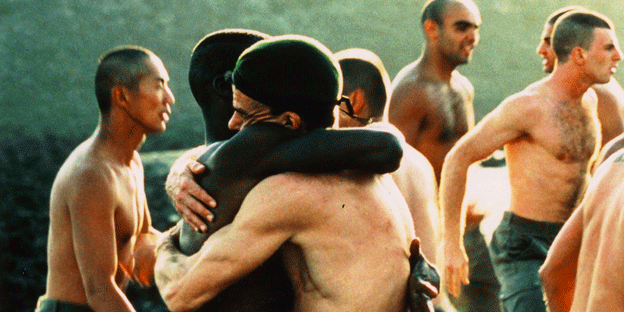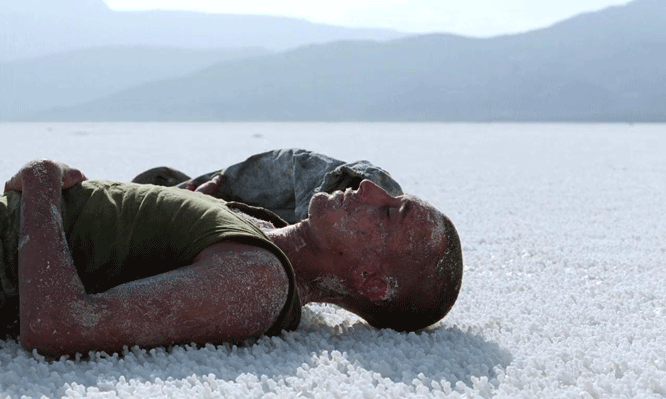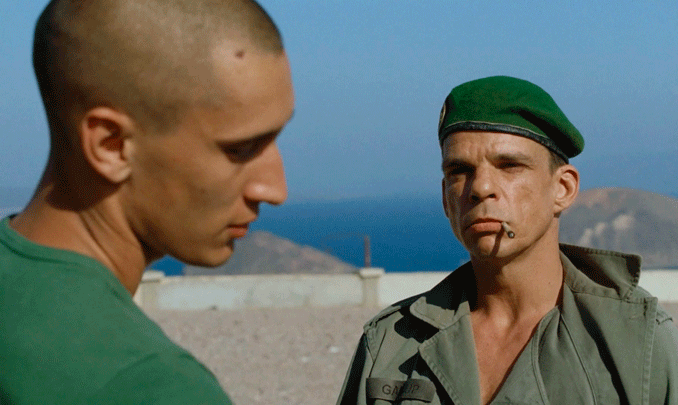Claire Denis’ Beau Travail (1999) begins with the close-up image of a mural, where silhouettes of soldiers are pressed against a red sky. The cracks and bumps form ridges across the mural, letting the shadow and light play with one another, as Adjudant-Chef Galoup, the leader of his section of the French Foreign Legion, narrates the events leading up to the end of his career.
Denis’ acclaimed Beau Travail captures the story of Adjudant-Chef Galoup as he recollects his time leading soldiers within the French Foreign Legion under the command of Commandant Forestier before he was recalled from service. His cruelty, and likely repressed homoerotic feelings, towards a young, handsome legionnaire, Sentain, culminates in his eventual downfall at his own hands.

His story is pressed against and engulfed by the landscapes of Djibouti. Denis’ use of the camera allows the story to tell itself, with the camera embodying a feminine gaze that looks towards the relationship between the military apparatus, the masculine identity, and the ghosts of colonialism.
The feminist politics of the lens confronts the phallic nature of the camera. Denis orchestrates the film, holding the camera as a kind of sympathetic mediator between the audience and the story. The film is textured; it focuses on the literal, the small, the insignificant. The camera in Beau Travail describes, not explains.
“I am trying to float on the impression of what a story could be,” says Denis in an interview with The Guardian. “But for me, cinema is not made to give a psychological explanation, for me cinema is montage, is editing.”
In revealing details, the film trusts the story to unfold and trusts the audience to understand and explore it. It embraces the senses, allowing the audience to meditate on its somatic beauty. Here, the feminist responsibility of acknowledging the gestures and actions, unrecognized or ignored, is foregrounded. It details even minuscule moments that would be forgotten or unseen otherwise, like the way the sand swirls around the desert plants as their leaves and shadows bend in the wind.

In understanding this, Beau Travail chooses to negate the use of landscape imagery as it has been complicit in constructing Western ideas of racial, sexual and gender identities. Rather than creating images of landscapes and the female body framed for male visual pleasure, Denis acknowledges the diverse and contingent ways of representing the landscape.
Denis questions the rigid gender positions in film. In doing so, she does not simply switch positions where men are equated to women — where the feminized male body is posed against the picturesque landscape — and thereby maintaining the status quo.


In positioning the landscape and the male bodies with one another, Denis produces an intimate tactile presence of the body, of desire and sexual pleasure. Through her work, Denis entangles the United Nations Sustainable Development Goals for Gender Equality, Peace, Justice and Strong Institutions, and Life on Land.
The bodies of people and of land communicate with one another, and for moments in time, are harmonious. Men are not hailed as conquerors but as equals, if not inferiors, to the land around them. Additionally, the landscape is not a passive backdrop for their activities but a force powerful and alive in its own right.
The compositional focus on the body and the land also allows for commentary on colonialism. In the desert, the soldiers seem to be an idle force. In the cityscape of Djibouti, the soldiers with their uniforms and (for most of them) non-native tongues contrast with the world around them, marking them as both a nuisance and entertainment for the local people.
Yet, shots of onlookers scattered all through the film make the audience aware that the troop is always observed by the local people, and that their presence remains as an inheritance of French colonial violence. Here, the camera keeps the focus on the brigade as a reversal of colonial desire; they are the ones on display.
The brigade also internally deals with race and religion in a colonial manner, as the Black soldiers are denied their African identity to be in service of that of a legionnaire, and religion is ignored in favour of the almighty ideals of the Legion. In these instances, the camera illuminates the power relations between the Black legionnaires and their white superiors by looking down on the legionnaires where they are able to comfortably look back.

For Denis, issues surrounding gender, race and sexuality seem to understand themselves within an interpersonal realm as well as a systemic one. While the story focuses on the individuals within the Legion, Denis does not shy away from larger social and political commentary. Although Denis has made blasé statements about Africa, African problems and gender-based violence, the camera allows Denis to articulate a (white) man’s experience of a traditionally toxic environment within a colonised country.
The camera enables her to rework traditional representational formats and cultural symbolisms because of its shift in spectatorship – her position as a white French woman who spent her early years in French-colonial Africa. Her films do not offer themselves with ease to the international market, as she thwarts the “default” of neoliberal cinema by centering her work as a cultural critique.
Galt labells Beau Travail as an example of “queer anti-neoliberalism” wherein the audience, understanding that the literal and small are important, can pay attention to details that not only make the film beautiful, but romantic, as homo-erotic undertones reach into many shots of the camera.
Denis contemplates the thoughts and feelings of her political engagement and finds ways to make it tangible within her filming.
The camera’s inherent ideological nature is not ignored but met with deep empathy for the subject matter, a feeling which translates onto the screen. Beau Travail navigates the terrain of desire and territory of exploitation and deviates from normative narratives.
Here, the camera looks, but it is Denis looking through it, holding its gaze.
See more of Denis’ works here.
